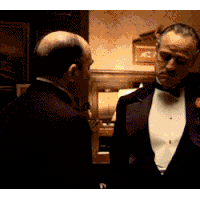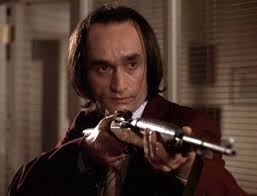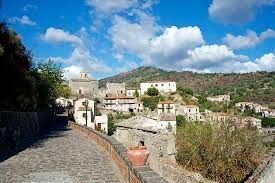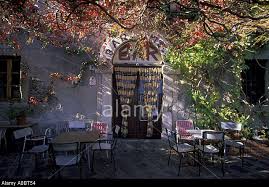
The Film:
The Godfather, directed by Francis Ford Coppola in 1972.
The Success:
The online box-office reporting service, Box Office Mojo summarizes that by the time it finished its run, “The Godfather” had the biggest box office gross of all time with $134 million in the United States and $245 million worldwide. It would continue to be the highest-grossing film until “Jaws” (1975). It won Oscars for best picture, actor with Marlon Brando, and adapted screenplay, and was also nominated for three best supporting actor awards with James Caan, Robert Duvall, and Al Pacino, as well as best director, editing, costume design, sound, and musical score. The Motion Production Code followed by the industry from 1930 until it was replaced by the MPAA rating system in 1968 determined that criminal action in movies had to be punished, and that sympathy towards criminals couldn’t be portrayed or suggested. The Godfather is told entirely from the point of view of the criminals, the only law enforcement figure with more than a couple lines of dialogue is crooked and while a few individuals get comeuppance, it’s not because they broke the law. Though not mentioned in the film, the sense of the Mafia life is flaunted in this story.
The Reason:
I did not get to see this movie until I was 11, about ten years after it was released. I remember hearing my uncles talk about it and how long it was and how criminal life was violent. I would see the title logo in different places or books. And I thought it was a movie about puppets. And years later I would understand that this symbolizes the control that the Godfather in the film had, and how he can control people for the sake of the Family. When I first saw it I did not fully understand the symbolism and underlining meaning to many things in the movie. I just knew it had action and old things. I enjoyed seeing old things. I was into watching gangster films of the 1930′ and 40’s, James Cagney’s “The Public Enemy” or Humphrey Bogart’s “Dead End”. Those films always had the gangster getting what’s coming to them but from an audience’s perspective. “The Godfather” is told from the criminal’s viewpoint. I thought that was different.
Cinematography:
The Writer/The Script:
Mario Puzo wrote the novel and the screenplay was written by both Francis Ford Coppola and Mario Puzo.
The Shots:

In the opening scene, Coppola uses an over-the-shoulder shot. This is a shot where the camera is positioned behind one of the actor’s shoulder, usually during a dialogue. It suggests a connection between the talkers as opposed to the single shot that suggests detachment. Throughout the sequence, Coppola uses a variety of shots. These fluctuate from slow zooms outwards, which is meant to draw the viewer in, to the over-the-shoulder shots which are a creative way of representing a conversation. These types of shots add variety for the audience, as well as being very effective in understanding the point of the conversation.
The Transition:
In “The Godfather” all the scenes that transition up until Michael Corleone kills both Sollozzo and Captain McCluskey have some sort of action or story continuity. Recognizing major transitions between the Acts of most movie can be tricky. But after the double murder the audience gets somewhat of an abstract montage with various newspaper images, and the music changes from dramatic instrumental to ragtime piano music, and it is by these methods that Coppola is letting the audience know this is the end of Act I and that everything after the murders will be different.
The Actor:


I saw “Dog Day Afternoon” (1975) before I saw The Godfather. And John Cazale’s intense character stuck out to me in “Dog Day” so I was expecting sort of the same personae in “Godfather.” Not at all. Cazale portrayed Fredo Corleone, considered as the weakest and least able of the three Corleone brothers, hence he is often given the basic jobs. But Fredo is the most willing and dutiful of the Corleone children. Cazale brought subtlety and depth to the film. As the film progresses so does Fredo. I the beginning he’s in the background or on the side but when Don Corleone gets shot Fredo comes forth to the audience. Still weak and obedient but the pain and vulnerability seen in his character intensifies towards the end. Not the same intensity as in “Dog Day” but a whole different level of reserved emotion. And it’s released as Fredo obedience transitions to self-interest after being passed over in the family business.
The Symbolism:

Throughout the years I would read in articles, see in documentaries, hear from film critics or just listen to friends about different uses of symbolism in “The Godfather.” One of the many pieces of information that stuck with me just because I found it odd was the use of oranges in the film. Coppola uses oranges as a foreshadow suggesting that they imply death or some violent event for the character mingling with the orange somehow. And Francis Ford Coppola validates this story in his audio commentaries on the DVD sets. Another form of symbolism relates to the term “sleeping with the fishes” used in the film.

An example is when Luca Brasi, Don Corleone’s devoted hitman, gives the impression that he’s about to switch sides and go with the rival crime-family. Brasi walks in a lounge and the door that leads to the bar. As the scene is shot looking in the camera catches Luca from behind so the audience will notice the fish designs etched into the glass. The visual impression is that the fish are staring to surround Brasi’s body, thus sealing his fate. Moments later, Sonny Corleone receives a package with Luca Brasi’s bulletproof vest containing fishes. “Sleeping with the fishes” meant utter death at the bottom of the ocean.
The Sound:
In the scene where Michael commits his first murder the sound of a screeching train can be heard almost overpoweringly in the background. Much louder than what should be heard sitting in a restaurant. The sound adds symbolism to this scene as well. It can be indicative of Michael heading off the rails in to a new life.
The Music:
The Godfather’s soundtrack, released in 1972 received an Oscar for best original score. Ten out of the twelves songs in the film were composed by Nino Rota and conducted by Carlo Savina. “The Godfather Love Theme” is an instrumental version of “Speak Softly, Love.” One of those rare times when the music is so tied with the film, that whenever I hear it, I instantly get in the mood to watch the entire trilogy all over. The song “I Have but One Heart” composed by Johnny Farrow, is sung by Al Martino, who performed it in the film as character Johnny Fontane (Welsh, Phillips, and Hill, 2010). Carmine Coppola, father to the director, provided additional music during the opening wedding scenes.
One of my favorite settings was when Michael had to leave the US after killing two rivals. His safe haven was Corleone, Sicily, (the namesake of Don Vito). My reaction when I first saw the film has changed over the years. When I first saw the film I was into an antique phase. I enjoyed seeing old things and trying on my grandfather’s hats. I thought all of Italy was like those scenes in “The Godfather.” I thought it was hot and dry. But I also thought it was peaceful and beautiful. Unfortunately, the actual city was too developed in the early 1970s to be used for filming. So, the Sicilian towns of

Savoca and Forza d’Agro outside of Taormina were used instead (TheGodfatherTrilogy.com, 2015). I lived in Italy and love the rustic scenery of unspoiled hill town. The scenes in the film always bring back great memories of sitting in a bar (café) drinking my cappuccino eating my cornetto.
The Make-up/The Costumes:

While preparing for the role of Don Vito Corleone, Marlon Brando wanted to portray Don Corleone with “sagging jowls”, so he stuffed cotton wool in his cheeks for the audition (Lebo, 2005). For the actual filming, Brando wore a mouthpiece made by a dentist. The mouthpiece is on display in the American Museum of the Moving Image in Queens, New York. Cinematographer Gordon Willis was forced to use overhead lighting for Marlon Brando’s scenes because of his makeup. He decided to extend it throughout, which is one reason the movie is so dark (Visions of Light 1992).

Anna Hill Johnstone was the costume designer of the film. I believe one of the most significant aspects of this film is the visual theme. The costumes used in this film represented a realistic picture of a crime family and they also suggest important changes in the lives of some of the main characters. For instance, after the failed attempt on Don Corleone’s life the decision is made for him to step down as Don. After, he is no longer shown in a stylish and expensive suits. Instead, the former Don appears in sweaters and more casual pants. The costumes give the impression of an older and more relaxed person. And as the fashion of the former Don begins to drift so does his position as the Godfather. In contrast, Michael Corleone’s character begins to take the place of his father and just like Don Vito, Michael’s costumes represent change. In the beginning of the film, Michael is shown in a military uniform. He doesn’t wear an expensive suit which most of the members of the Corleone family are seen wearing. However, once Michael begins to participate in the family business, his style of clothing seems to change. By the end of the film as Michael is becoming the Godfather, his outfits have completely changed. Michael Corleone is shown in expensive powerful looking suits, hats and ties. He looks the ready to take over the family business.
The Lighting:
 Before Gordon Willis, director of photography, shot “The Godfather”, movies were extremely over lit so they could be seen in the drive-ins and not disappear into the dark of the night. But Willis’ cinematography was a bold step forward, changing the look of movies forever. Because of “The Godfather”, studios actually had to make two sets of prints, a lighter one for drive-ins, and a darker one for theaters (Visions of Light, 1992). Willis would go on acknowledging that he used “yellow” color throughout the film. A color indicative of period films, like “The Godfather.”
Before Gordon Willis, director of photography, shot “The Godfather”, movies were extremely over lit so they could be seen in the drive-ins and not disappear into the dark of the night. But Willis’ cinematography was a bold step forward, changing the look of movies forever. Because of “The Godfather”, studios actually had to make two sets of prints, a lighter one for drive-ins, and a darker one for theaters (Visions of Light, 1992). Willis would go on acknowledging that he used “yellow” color throughout the film. A color indicative of period films, like “The Godfather.”
The End:

I keep finding more and more symbols, hidden meaning or innuendos each time I watch it. I enjoy sharing this film with people who haven’t seen it fully through. What keeps drawing me to continuously watch “The Godfather” over the years is its ability to demonstrate what a person is willing to do for reasons they believe are worthy. And what better reason than family. It may be business and it may not always be personal but it is always about the Family. My emotions are amazement; at the power a family can have when focused, frustration; as Sonny looses his cool and meets is doom, satisfaction; as Michael gets redemption in the restaurant, sadness; the meaningless death of Michael’s first wife, and awe; as Don Michael Corleone cleans house and takes care of business.
The Sources:
Film Studies 101: The 30 Camera Shots Every Film Fan Needs To Know. Emprieonline.com. Web. 04 August, 2015. http://www.empireonline.com/features/film-studies-101-camera-shots-styles/p2
Lebo, Harlan. The Godfather Legacy: The Untold Story of the Making of the Classic Godfather Trilogy Featuring Never-Before-Published Production Stills. Simon and Schuster, 2005.
TheGodfathertrilogy.com. The Godfather: Sicilian Shooting Locations. Web. 04 August, 2015. http://www.thegodfathertrilogy.com/gf1/gf1scene_sicily.htm
Visions of light: the art of cinematography. Image Entertainment, 1992. Web. 04 August, 2015. https://www.youtube.com/watch?v=kvA93wEu_8E
Welsh, James M.; Phillips, Gene D.; Hill, Rodney F. The Francis Ford Coppola Encyclopedia. Lanham, Maryland: Scarecrow Press. (2010).
